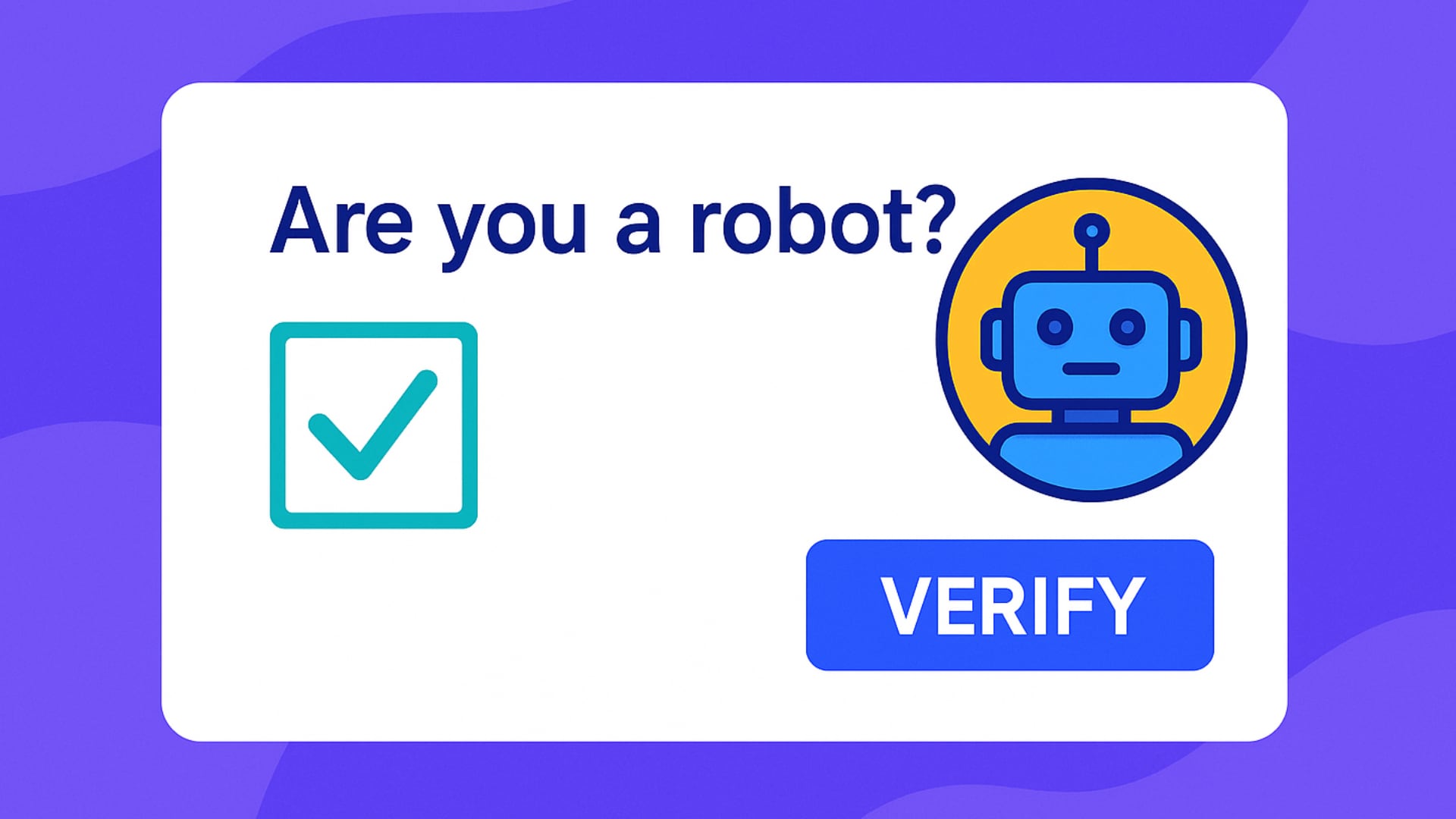
You’ve likely seen Google’s famous “I’m not a robot” checkbox numerous times while browsing the web. This simple prompt has become an iconic part of online experiences, but what happens behind the scenes is worth exploring. Beyond the user-friendly surface, Google’s approach to verifying human users raises important privacy concerns, especially for businesses in Europe. As European companies navigate the complexities of privacy regulations, many are seeking alternative solutions that better align with the General Data Protection Regulation (GDPR) and prioritize user privacy.
Table of contents
- The Evolution of CAPTCHA and Digital Identity Verification
- What Happens When Google Asks If You’re a Robot?
- The Privacy Trade-off: Data Collection vs. User Privacy
- Privacy-First Alternative: Advanced CAPTCHA Solutions
- User Experience: Privacy and Convenience Combined
- The Future of CAPTCHA: Privacy-First Verification Solutions
The Evolution of CAPTCHA and Digital Identity Verification
In the early days of the internet, CAPTCHAs often consisted of distorted text that users had to decipher to prove they were human. This simple challenge was an effective deterrent for bots, but as technology advanced, the need for a more user-friendly approach became apparent. Google’s “I’m not a robot” checkbox was introduced as a simpler, less intrusive way of verifying human users. However, this method also introduced new privacy concerns that are particularly significant for businesses operating under GDPR in Europe. While this solution is convenient, it collects a large amount of behavioral data, which can conflict with privacy-focused principles and regulations.
What Happens When Google Asks If You’re a Robot?
When Google asks you to confirm you’re not a robot, it’s not just a simple box you tick. The verification process involves more than just a quick click; Google uses behavioral analysis to determine if the interaction is human. This analysis includes tracking data such as mouse movements, clicks, typing speed, and even browsing history (if logged into Google services). These data points help Google assess whether the user is a bot or a real person.
For businesses operating in Europe, this creates a dilemma. While this method provides security, it also involves extensive data collection, which could be problematic under GDPR. European businesses must ensure that their methods for verifying users respect privacy regulations, and Google’s CAPTCHA solution doesn’t offer the necessary transparency or compliance for many.
The Privacy Trade-off: Data Collection vs. User Privacy
Google’s CAPTCHA method may appear simple, but it collects substantial data to analyze user behavior. This data collection includes not only the user’s interaction with the CAPTCHA itself but also potentially sensitive information such as browsing history and location. In the context of GDPR, this is problematic because businesses must obtain explicit consent to collect and process personal data.
European businesses must weigh the benefits of using Google’s CAPTCHA system against the privacy concerns raised by such extensive data collection. Compliance with GDPR requires careful consideration of how data is collected, stored, and used. Google’s system, while effective in terms of user verification, may force businesses to disclose more information to users about data usage than they are comfortable with, especially when it comes to behavioral tracking.
Privacy-First Alternative: Advanced CAPTCHA Solutions
Consider this scenario: A European e-commerce platform using Google’s solution might unknowingly expose their users to data collection that extends beyond their own website. Under GDPR, this creates potential liability issues and might require additional privacy policy disclosures.
Given the privacy challenges associated with Google’s system, privacy-focused CAPTCHA solutions like Captcha.eu offer an alternative. Captcha.eu combines cryptographic proof-of-work with anonymized behavioral analysis to ensure robust verification without compromising privacy.
While Captcha.eu does use anonymized data signals such as IP addresses and user interactions to detect bots, it does so in full compliance with GDPR. These signals are anonymized, meaning no personal information is stored or shared with third parties, ensuring users’ privacy remains protected. This approach strikes a balance between security and privacy, offering businesses a way to prevent automated attacks while respecting the user’s rights.
In comparison to Google’s method, which tracks personal data, Captcha.eu focuses on ensuring that data collection is minimized and GDPR-compliant. The process is seamless and transparent, with no unnecessary data being collected, ensuring that businesses can secure their websites without infringing on user privacy.
User Experience: Privacy and Convenience Combined
Google’s CAPTCHA solution requires users to engage with tasks like selecting images or solving puzzles. These additional steps can sometimes create friction, especially on mobile devices or when users need to complete a task quickly.
In contrast, Captcha.eu works quietly in the background, requiring no direct user interaction in most cases. It offers robust protection against automated attacks while providing a seamless and faster experience for users. This improves the user experience significantly, allowing businesses to maintain high security without frustrating their customers.
The European Advantage: Aligning with European Values
For European businesses, using a privacy-first CAPTCHA solution isn’t just about meeting legal requirements; it’s also about aligning with the core values of European privacy. Europeans are increasingly concerned about how their data is collected and used online. A growing number of consumers are choosing to engage with businesses that respect their privacy by design, not as an afterthought.
By opting for a Captcha.eu solution, businesses show that they prioritize both security and user privacy. It’s a win-win for businesses that want to ensure compliance with GDPR while building trust with their customers.
Data Sovereignty: Keeping Data Within the EU
An important aspect of choosing a GDPR-compliant CAPTCHA solution is data sovereignty. Unlike Google’s global network, which processes user data across multiple regions, Captcha.eu ensures that all data processing happens within the EU. This helps businesses maintain control over their data, making sure it is handled in compliance with GDPR.
Processing data within the EU borders also reduces the risk associated with international data transfers and ensures that data is stored and processed in a region with strong privacy protections.
The Future of CAPTCHA: Privacy-First Verification Solutions
As privacy regulations continue to evolve, the future of CAPTCHA is clear: it’s not just about verifying if users are robots — it’s about creating secure, privacy-focused verification systems that respect user rights. Captcha.eu is leading the way in this transition, offering cryptographic CAPTCHA solutions that prioritize user privacy while still providing robust security.
Businesses are increasingly recognizing the importance of choosing solutions that not only comply with privacy laws but also build trust with users by respecting their data. The future of human verification is about offering seamless, secure, and privacy-respecting solutions that align with both regulatory requirements and user expectations.
Making an Informed Choice: Key Considerations for CAPTCHA Solutions
When evaluating CAPTCHA solutions for your business, here are a few important questions to ask:
- Where is user data processed? Make sure the solution processes data within the EU to ensure compliance with GDPR.
- What data is being collected? Opt for solutions that minimize data collection and don’t track or store unnecessary personal data.
- How does the solution align with GDPR? Look for solutions that are fully compliant with GDPR and respect user privacy by default.
- Does it provide robust security without compromising privacy? Ensure the solution offers strong protection while safeguarding user privacy.
Taking Action: Protect Your Website with a Privacy-First CAPTCHA Solution
If you’re ready to secure your website while respecting European privacy values, explore how Captcha.eu can provide GDPR-compliant protection using cryptographic CAPTCHA systems. Offering robust security without compromising user privacy, Captcha.eu ensures that your business can stay ahead of evolving privacy regulations.
Visit Captcha.eu to learn more about how leading European businesses are securing their digital presence while respecting user privacy.
100 free requests
You have the opportunity to test and try our product with 100 free requests.
If you have any questions
Contact us
Our support team is available to assist you.




